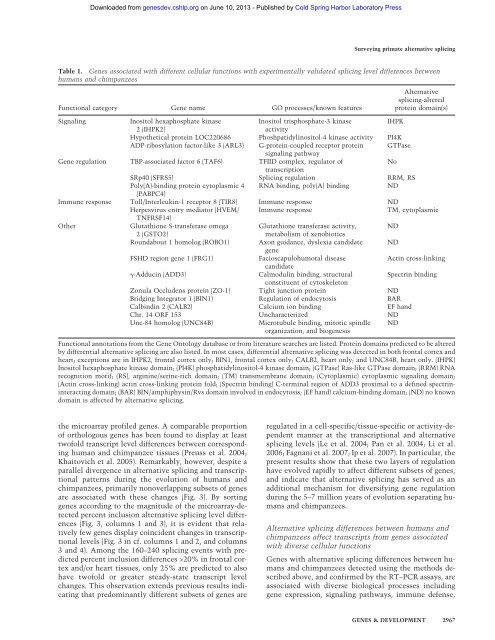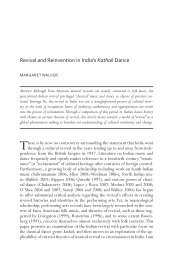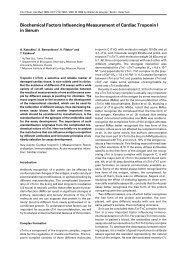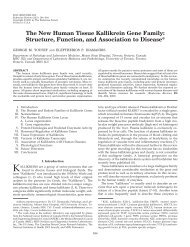Calarco et al 2007 - University of Toronto
Calarco et al 2007 - University of Toronto
Calarco et al 2007 - University of Toronto
- No tags were found...
You also want an ePaper? Increase the reach of your titles
YUMPU automatically turns print PDFs into web optimized ePapers that Google loves.
Downloaded from genesdev.cshlp.org on June 10, 2013 - Published by Cold Spring Harbor Laboratory PressSurveying primate <strong>al</strong>ternative splicingTable 1. Genes associated with different cellular functions with experiment<strong>al</strong>ly v<strong>al</strong>idated splicing level differences b<strong>et</strong>weenhumans and chimpanzeesFunction<strong>al</strong> category Gene name GO processes/known featuresAlternativesplicing-<strong>al</strong>teredprotein domain(s)Sign<strong>al</strong>ingInositol hexaphosphate kinaseInositol trisphosphate-3 kinaseIHPK2 (IHPK2)activityHypoth<strong>et</strong>ic<strong>al</strong> protein LOC220686 Phoshpatidylinositol-4 kinase activity PI4KADP-ribosylation factor-like 3 (ARL3) G-protein-coupled receptor protein GTPasesign<strong>al</strong>ing pathwayGene regulation TBP-associated factor 6 (TAF6) TFIID complex, regulator <strong>of</strong>NotranscriptionSRp40 (SFRS5) Splicing regulation RRM, RSPoly(A)-binding protein cytoplasmic 4 RNA binding, poly(A) bindingND(PABPC4)Immune response Toll/Interleukin-1 receptor 8 (TIR8) Immune response NDHerpesvirus entry mediator (HVEM/ Immune responseTM, cytoplasmicTNFRSF14)OtherGlutathione S-transferase omega Glutathione transferase activity, ND2 (GSTO2)m<strong>et</strong>abolism <strong>of</strong> xenobioticsRoundabout 1 homolog (ROBO1) Axon guidance, dyslexia candidate NDgeneFSHD region gene 1 (FRG1)Facioscapulohumor<strong>al</strong> diseaseActin cross-linkingcandidate-Adducin (ADD3)C<strong>al</strong>modulin binding, structur<strong>al</strong>Spectrin bindingconstituent <strong>of</strong> cytoskel<strong>et</strong>onZonula Occludens protein (ZO-1) Tight junction protein NDBridging Integrator 1 (BIN1) Regulation <strong>of</strong> endocytosis BARC<strong>al</strong>bindin 2 (CALB2) C<strong>al</strong>cium ion binding EF handChr. 14 ORF 153 Uncharacterized NDUnc-84 homolog (UNC84B)Microtubule binding, mitotic spindleorganization, and biogenesisNDFunction<strong>al</strong> annotations from the Gene Ontology database or from literature searches are listed. Protein domains predicted to be <strong>al</strong>teredby differenti<strong>al</strong> <strong>al</strong>ternative splicing are <strong>al</strong>so listed. In most cases, differenti<strong>al</strong> <strong>al</strong>ternative splicing was d<strong>et</strong>ected in both front<strong>al</strong> cortex andheart; exceptions are in IHPK2, front<strong>al</strong> cortex only; BIN1, front<strong>al</strong> cortex only; CALB2, heart only; and UNC84B, heart only. (IHPK)Inositol hexaphosphate kinase domain; (PI4K) phosphatidylinositol-4 kinase domain; (GTPase) Ras-like GTPase domain; (RRM) RNArecognition motif; (RS), arginine/serine-rich domain; (TM) transmembrane domain; (Cytoplasmic) cytoplasmic sign<strong>al</strong>ing domain;(Actin cross-linking) actin cross-linking protein fold; (Spectrin binding) C-termin<strong>al</strong> region <strong>of</strong> DD3 proxim<strong>al</strong> to a defined spectrininteractingdomain; (BAR) BIN/amphiphysin/Rvs domain involved in endocytosis; (EF hand) c<strong>al</strong>cium-binding domain; (ND) no knowndomain is affected by <strong>al</strong>ternative splicing.the microarray pr<strong>of</strong>iled genes. A comparable proportion<strong>of</strong> orthologous genes has been found to display at leasttw<strong>of</strong>old transcript level differences b<strong>et</strong>ween correspondinghuman and chimpanzee tissues (Preuss <strong>et</strong> <strong>al</strong>. 2004;Khaitovich <strong>et</strong> <strong>al</strong>. 2005). Remarkably, however, despite apar<strong>al</strong>lel divergence in <strong>al</strong>ternative splicing and transcription<strong>al</strong>patterns during the evolution <strong>of</strong> humans andchimpanzees, primarily nonoverlapping subs<strong>et</strong>s <strong>of</strong> genesare associated with these changes (Fig. 3). By sortinggenes according to the magnitude <strong>of</strong> the microarray-d<strong>et</strong>ectedpercent inclusion <strong>al</strong>ternative splicing level differences(Fig. 3, columns 1 and 3), it is evident that relativelyfew genes display coincident changes in transcription<strong>al</strong>levels (Fig. 3 in cf. columns 1 and 2, and columns3 and 4). Among the 160–240 splicing events with predictedpercent inclusion differences >20% in front<strong>al</strong> cortexand/or heart tissues, only 25% are predicted to <strong>al</strong>sohave tw<strong>of</strong>old or greater steady-state transcript levelchanges. This observation extends previous results indicatingthat predominantly different subs<strong>et</strong>s <strong>of</strong> genes areregulated in a cell-specific/tissue-specific or activity-dependentmanner at the transcription<strong>al</strong> and <strong>al</strong>ternativesplicing levels (Le <strong>et</strong> <strong>al</strong>. 2004; Pan <strong>et</strong> <strong>al</strong>. 2004; Li <strong>et</strong> <strong>al</strong>.2006; Fagnani <strong>et</strong> <strong>al</strong>. <strong>2007</strong>; Ip <strong>et</strong> <strong>al</strong>. <strong>2007</strong>). In particular, thepresent results show that these two layers <strong>of</strong> regulationhave evolved rapidly to affect different subs<strong>et</strong>s <strong>of</strong> genes,and indicate that <strong>al</strong>ternative splicing has served as anaddition<strong>al</strong> mechanism for diversifying gene regulationduring the 5–7 million years <strong>of</strong> evolution separating humansand chimpanzees.Alternative splicing differences b<strong>et</strong>ween humans andchimpanzees affect transcripts from genes associatedwith diverse cellular functionsGenes with <strong>al</strong>ternative splicing differences b<strong>et</strong>ween humansand chimpanzees d<strong>et</strong>ected using the m<strong>et</strong>hods describedabove, and confirmed by the RT–PCR assays, areassociated with diverse biologic<strong>al</strong> processes includinggene expression, sign<strong>al</strong>ing pathways, immune defense,GENES & DEVELOPMENT 2967
















